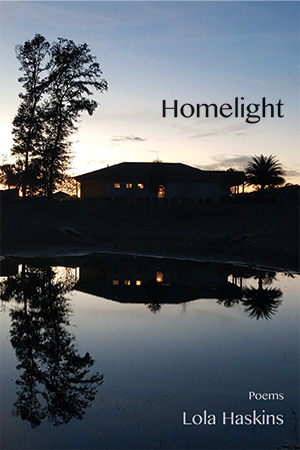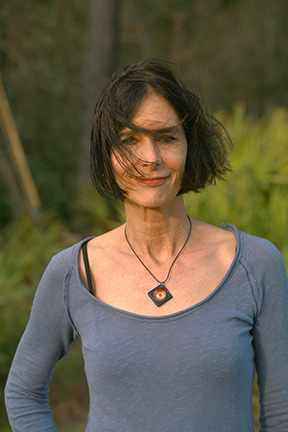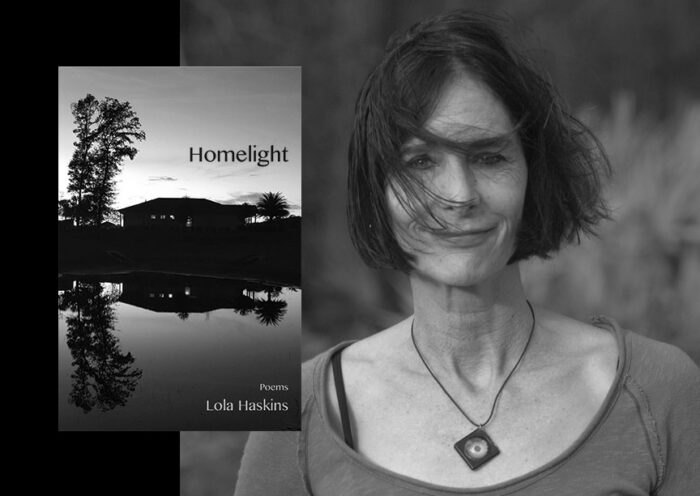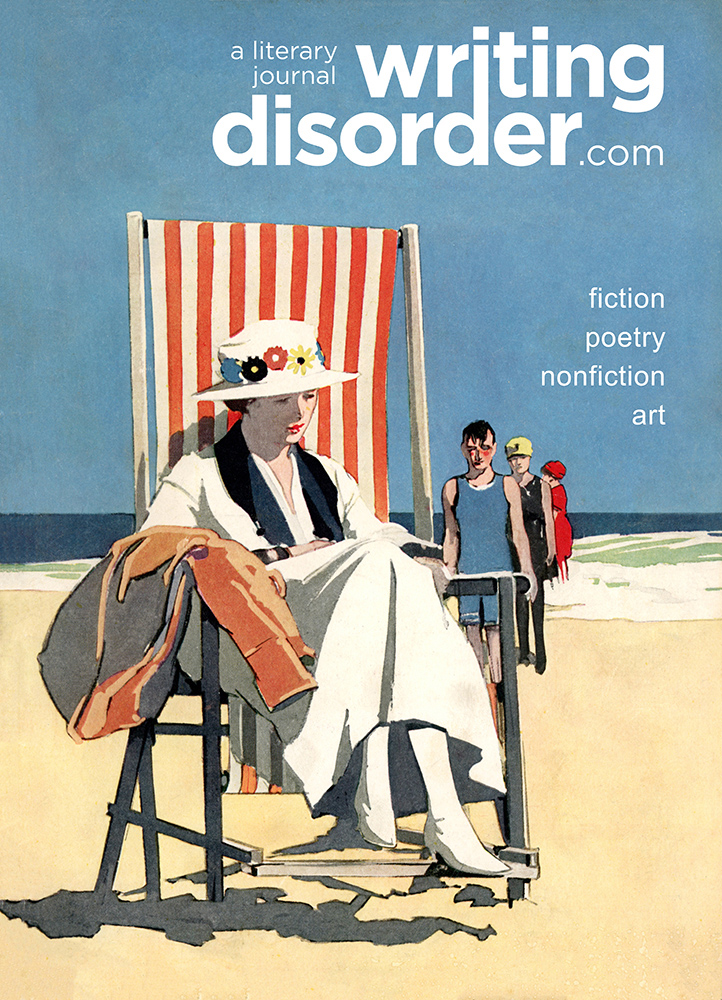Reviewed by Claire Hamner Matturro
The poems in Lola Haskins’ newest collection, Homelight (Charlotte Lit Press 2023), are equally elegant and eloquent in their graceful blend of theme, imagery, and language. Elegant in their refined, fluent use of words and eloquent in their visions and messages, these are luminous poems. While some poems are nearly haiku-short, others contain many stanzas, yet all resonate with beguiling, stirring words from a poet with a close connection to the natural world and an intense perceptiveness. There’s a spiritual quality to many of the poems, even a metaphysical element to some as in “The Discovery” where “time is as / random as the patterns the sun makes on / any given day…” As Haskins travels between accessible and elusive, the personal and the observational, Homelight offers a stunning collection of well-crafted, evocative poems which flow with a natural rhythm.

Organized into seven named sections, these 63 poems are diverse in their topics. In part one, titled “On the Shoulders of Giants,” Haskins writes in the style of such renowned poets as William Blake, W. S. Merwin and Mary Oliver. In part two, “Wings,” she celebrates wild birds, often a topic of hers in prior collections. Other named sections include: “And They Are Gone,” “(In)humanity,” “Corona,” “The Slapped Girl,” and “Rehearsing.”
Haskins’ talent for the poetry of nature is well established with her prior books and her poems of the natural world stands out superbly in Homelights too. As a long-time environmentalist and outdoors enthusiast, she occasionally tilts these poems toward a world-weary awareness of what we are damaging and seeing slipping away. In “Dominion,” she questions when we will understand how “the tips of our fingers / are like yellow butterflies? Reach for them and they are gone.” In “Those Who Look Alike but Are Not,” she ends the poem with “They are not the ones destroying the world.” Yet, the poems usually lend themselves to hopefulness and celebration of what we still have as she finds a yin and yang equilibrium. For example, in “The Hundred and One Names of the Wind,” Haskins rejoices in the wind for “its voices / have taught us song, / and its swaying dance.” Yet, she also recognizes “for any day / of the world it may crush us under / our houses.” In the end, she wonders “be we wise or foolish do we / understand what we have done.”

Haskins’ vivid use of metaphors, simile, and precise, unique descriptions is so powerful that images lifted from the natural world become so much more—which of course is the alchemy in truly good poems. In “The Salt Marsh,” for example, “At dusk the water turns melted pearl” and in, “Mercy, Pity, Peace and Love,” readers find “The earth is a kind chair. When I have stopped breathing she will not tell me / I must get up.” In “At the Park,” robins “drab as dead leaves” nonetheless rise “like children swinging / lanterns, stars among the darkened trees.” And the bird in “The Woodpecker” will “hammer at the tree / like a resolute / toddler / pounding pegs.”
Among the nature and personal poems, a few are also topical. The pandemic appears in the section titled “Corona, 2019-2021” where in a poem entitled “Woods,” Haskins observes sharply that “Home and here are / the only places / I’m allowed / now the world is sick.” Yet, even in that narrowed space, she finds beauty—“A tiny violet moth / has fallen in love / with my socks.”
Other topical poems include “Aleppo,” where a Syria father “speaks of his six month old boy, born here / who has never seen the sky.” In “Bear,” referencing Ukraine, she writes:
If a group of bears attacks your village, lie still.
If they are not fooled, fight back with everything they are trying to rip out.
If this means you have to set fire to your country, do it.
The most deeply personal poems are those in “The Slapped Girl” and in “Rehearsing.” One of the poems in those sections is a bittersweet, haunting love poem entitled “Though We Can Never Be Together.” In only twelve sublime lines, the poem captures both a story and a feeling, beginning with this line: “I live with you / in the interstice between breath and breath / in the cool damp hollows tides leave in the sand” and ending with these words:
And I wear you
the way a Sikh wears his cord
under his clothes
in token of the ineffable beauty of the world.
All in all, these are rich, layered poems of beauty and transcendence which once more establishes Lola Haskins as a poet worthy of her many accolades and worthy of reading, re-reading, and cherishing.
Lola Haskins’ poems have been broadcast over the BBC and her work has appeared in such prestigious publications as The Atlantic, London Review of Books, The New York Quarterly, Georgia Review, Rattle, Prairie Schooner, and others. Her body of work also includes thirteen previous collections of poetry, a beginner’s guide to the poetry life, and a non-fiction book about Florida cemeteries. Twice nominated for a Pulitzer Prize, she has been honored with three book prizes, two NEA fellowships, four Florida Cultural Affairs fellowships, the Emily Dickinson/Writer Magazine award from Poetry Society of America, and many others.
Dominion
By Lola Haskins, from Homelights and used with permission
We name the birds and think those are their names
but our throats are helpless when calling flights pass over
and we can’t taste the earth that comes up with the worm in a robin’s beak
nor in the worst moments of our lives can we approach the way an owl sobs.
We analyze the sky using charts one phenomenon at a time
yet when light pierces the clouds like our visions of God we turn into
open mouths and when that light enters us no matter how much
we want to keep it because we do not have the tools we can never.
We wade through undergrowth whose leaves and sticks are our words for them
but the nodules and stitchings on our ankles will always know more about plants
than we do and we have no idea what to call the way trees dwarf us nor when
we hold them how to interpret the patterns their barks leave on our cheeks.
We have stories but we cannot parse them so when we step on a seedling struggling
through a crack we never think of Cain and Abel nor does the way water
cascades towards us from high and ancient rock bring Rapunzel to mind
nor when we look at the stars do we remember As it was in the beginning.
When will we understand that all our classifications are only attempted dust?
That nothing pinned to a card is true? That sight and hearing
and taste and our hearts and our brains and the tips of our fingers
are like yellow butterflies? Reach for them and they are gone.
BIO
Claire Hamner Matturro has been a journalist, lawyer, organic blueberry farmer, and college instructor. She is the author of eight novels, including a series published by HarperCollins. Her poetry appears in Slant, Kissing Dynamite, New Verse News, One Art, Muddy River Poetry Review, Tiger Moth Review, Lascaux Review, and Glassworks. Her reviews of poetry appear in Southern Literary Review, where she’s an associate editor, and in Slant, Compulsive Reader, and Verse-Virtual.



















